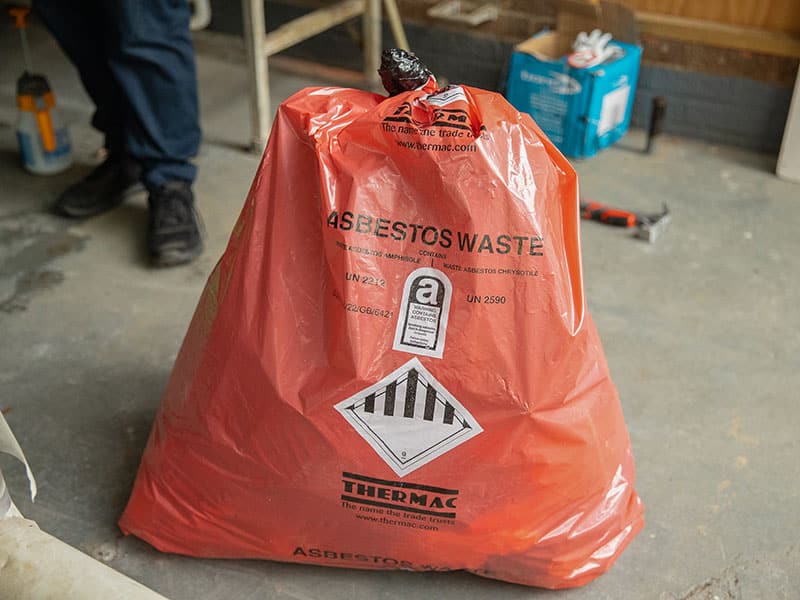DIY asbestos removal: Can I remove asbestos myself?
Before its health effects were widely known, asbestos was considered to be a sort of wonder material. Asbestos is highly resistant to fire, which meant it could keep buildings safe, and it’s also excellent for insulation. Plus, its cheap cost and wide availability made it a popular choice for residential homes as well as commercial buildings and even car parts.

However, once its life-threatening health impacts were discovered, asbestos was no longer a responsible choice. Since asbestos wasn’t banned in the UK until 1999, though, any buildings that pre-date 2000 are likely to contain asbestos.
If you know or assume that a building you’re responsible for has asbestos-containing materials (ACMs), you may be wondering if it’s safe to remove the asbestos yourself. Plus, with the rising trend of DIY home renovations, asbestos management and removal is a necessity for many homeowners.
In this article, we’ll discuss the feasibility and safety of DIY asbestos removal and when it’s best to hire a professional.
What is asbestos and where is it found?
Asbestos is a naturally occurring, fibrous mineral that has fireproofing and insulation properties. It’s also a carcinogen that can cause mesothelioma and contribute to other cancers, including lung cancer.
There are a few different types of asbestos, with some posing a greater risk than others. However, there is no safe type of asbestos or exposure event.
There are many places in a building or on a property where ACMs can be found, including:
- AC and heating units
- Bathrooms, including toilets
- Cement
- Electrical panels
- Pipe insulation
- Roofing and loft voids
- Textured coatings and paints
- Vinyl flooring and tiles
- Windows and doors
Asbestos exposure can cause severe illnesses, including different types of cancer, as long as 10 or more years in the future. Some people may not even realise they were exposed to asbestos at some point in their lives and still have to deal with a health crisis later in life.
Can I remove asbestos myself?
While it’s physically possible to remove ACMs yourself, it’s not recommended. You could unknowingly create an exposure event and put yourself and others in danger. You may also face legal implications if you try to carry out licence-only asbestos work without a license on a commercial property.
There are some types of low-risk asbestos work that you may be able to handle on your own, so long as you have the proper training. For high-risk asbestos work in a commercial building, though, a licensed contractor must carry out the work. The rules are different for residential properties, which we’ll talk about in a minute.
Ultimately, though, trying to remove asbestos, especially ACMs that are damaged or contain especially fibrous asbestos, can be extremely dangerous. It’s always best to hire a qualified professional or team of asbestos experts to handle the work for you.
What are the legal regulations surrounding asbestos removal?
Asbestos removal from a commercial building has strict laws that are overseen by the Health and Safety Executive. However, residential asbestos removal doesn’t have the same guidelines. The homeowner or contractors working in a home don’t need to be licensed, and they’re also not legally obligated to keep people on the premises safe.
While the HSE doesn’t have specific asbestos requirements for homeowners, you should always check with your local council to ensure you’re following its guidelines. You can enter your postcode here to find information about your area’s asbestos requirements.
Also, as asbestos poses such a serious and detrimental health risk, it’s ethical to go about asbestos work, including removal, in the safest way possible. That’s the only way to keep yourself, members of your household, visitors, workers, and even passers-by protected
A licence is required if you’re going to perform medium- to large-scale work on asbestos, such as demolition or removal, in a commercial building in the UK. If asbestos in a commercial building is mishandled, the duty holder, asbestos contractor, or other involved parties could be fined or even prison.
What are the risks of DIY asbestos removal?
In its undisturbed state, asbestos doesn’t pose a direct health risk. However, if an ACM has been disturbed or damaged in any way, it can release microscopic asbestos fibres. Those fibres are impossible to detect, as they can’t be seen with the naked eye, and they don’t have a smell or taste, either.
When inhaled or swallowed, asbestos fibres can attach to a person’s lungs. Once there, they’re extremely difficult to detect or remove. Over time, cancers or other diseases that impact the respiratory system can develop.
Even if an ACM is not currently damaged, it can be damaged during the removal process. For example, an ACM that seems to be in good condition can break during removal. Or, asbestos can be disturbed if you or a worker doesn’t know of its presence.
That’s why it’s always best to hire experts regardless of the quantity or type of asbestos you’re dealing with.
Who is legally allowed to remove asbestos?
To stay within the law, either a trained or licensed individual or team should be the only people handling asbestos. Whether training, licensing, or both are needed depends on the work that needs to be done and the risk involved.
Here’s a brief overview, and you can learn more about licensed vs. non-licensed asbestos work in this article.
- Removing low-risk ACMs that are in good condition may not require a licence.
- Removing highly friable ACMs — meaning the asbestos can easily break down and release fibres — requires a licence.
- Complex removal situations that require a high skill level typically require a licence.
It’s important to note that even if your asbestos removal project falls under the low-risk, non-licensed category, that doesn’t mean that anybody can do it. Asbestos is still extremely dangerous and only someone with experience or training should work with it.
Is it best to use a professional for asbestos removal?
If your property contains asbestos, it’s crucial that you address the situation immediately. More often than not, this involves hiring an asbestos professional to assess the situation, test materials, and potentially remove the asbestos.
Professional asbestos companies provide a variety of asbestos-related services that follow industry best practices and the HSE’s legal requirements. For example, at Oracle Solutions, we offer asbestos training, asbestos surveys, asbestos management, asbestos removal, and more.
In addition to expertise and the proper licensing, asbestos professionals also have the necessary equipment and personal protective equipment to handle all sorts of asbestos projects, including high-risk removal. You can also be sure that they’ll stay compliant with legal and safety standards so you can avoid putting others at risk and avoid legal trouble.
To choose an asbestos removal company, you should check for or ask about the following:
- If they have the proper licences for the type of work you need to be done
- What type of insurance coverage they have
- Industry accreditation that reinforces their expertise and knowledge
- The procedures and equipment they use for removal jobs
- How they dispose of asbestos waste
Additionally, you want to hire an asbestos removal company that’s open and transparent about its processes, background, and costs.
What are the alternatives to asbestos removal?
Asbestos removal can be a complex process. However, in some cases, there are better alternatives to removal.
Note that you never want to ignore asbestos, even if the property isn’t actively being used. Airborne asbestos fibres can contaminate air, water, and soil, so any asbestos that’s damaged or could be disturbed should be dealt with immediately.
Monitoring
If the ACMs are in good condition and not posing a threat, they may not require removal. Instead, monitoring the condition of the ACMs may be the best option. Attempting to remove an ACM can result in fibres being released, so it’s usually a solution that’s only used when necessary.
That said, you may require training to be able to locate ACMs in your home and know what disturbed vs. undisturbed asbestos looks like. You’ll also want to educate any other members of the household so they don’t accidentally damage ACMs.
Encapsulation
With encapsulation, the surface of the ACM is sealed to prevent asbestos fibres from escaping. Commonly, a special type of paint is used to encapsulate the ACM. The ACM has to be cleaned and treated before the paint can be applied.
This may be done before removal or as an alternative solution. Learn more about asbestos encapsulation here.
Final thoughts about DIY asbestos removal
While asbestos once had a lot of promise with its fireproofing and insulation properties, its health consequences are so severe that the only solution was to ban it completely. However, before the ban, asbestos was widely used in all sorts of building materials, including roofing, cement, paint, vinyl siding, and more.
Asbestos still exists in many UK properties today, including commercial buildings and residential homes. Homeowners should have the information needed to make wise, safe decisions for themselves and anyone in their household.
Contact one of our asbestos professionals today to discuss your asbestos removal needs.

Written by Callum McDonald
Callum McDonald is an expert in asbestos quality management, ensuring rigorous adherence to regulations and high-quality standards in removal projects. His focus on enhancing quality and client satisfaction makes him a crucial asset in safety and compliance within the field. Callum's expertise in technical support and oversight of licensed works underscores his commitment to excellence in asbestos management, providing invaluable guidance to clients in this specialised area.
